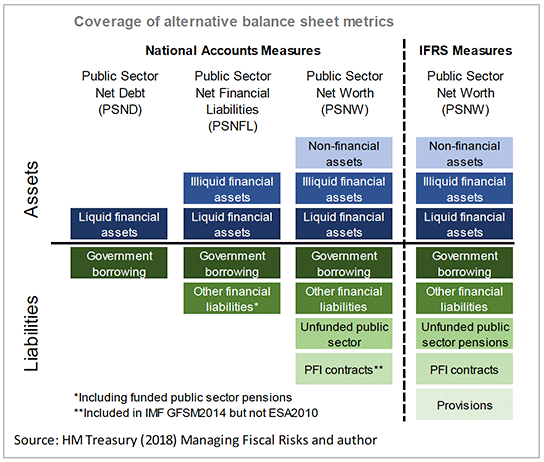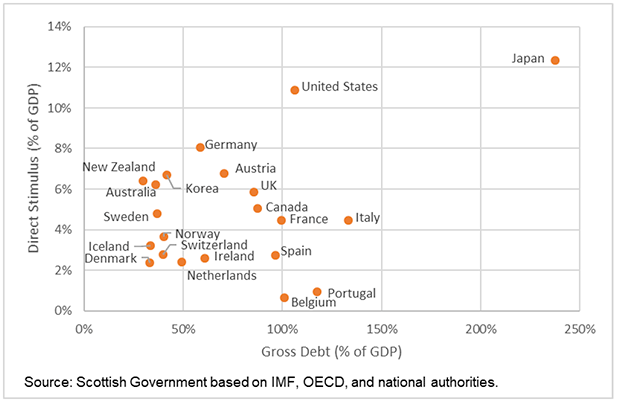Coronavirus (COVID-19): UK fiscal path – a new approach
This paper sets out ten principles the Scottish Government believes the UK Government should follow to support the UK economy and public finances as we begin to recover from the impacts of coronavirus.
Annex A: Further details of analysis
1. The Public Sector Balance Sheet
As illustrated in Chart 12, there are various statistical measures available to assess the health of the public sector finances. The UK Government's current preferred balance sheet measure, public sector net debt (excluding public sector banks), compares total outstanding government borrowing against liquid financial assets such as bank deposits and foreign exchange reserves.
Public sector net financial liabilities (PSNFL) include all financial assets, such as loans to students to pay for tuition feeds, derivatives and equity investment and the corporate bonds acquired by the Bank of England through its credit easing operations. Any sale or transfers of assets above/below their retention value would show up as a gain/loss to the taxpayer. The ONS began publishing quarterly data on PSNFL in November 2016 while the OBR began forecasting PSNFL in its 2016 Autumn Statement.

Chart 12 Description
A table showing different public sector balance sheet measures. The most narrow measure, Public Sector Net Debt only compares liquid financial assets with government borrowing. More comprehensive measures, such as Public Sector Net Worth also consider non-financial assets, illiquid financial assets, other financial liabilities, unfunded public sector pensions, and PFI contracts.
Public sector net worth (PSNW) is the most comprehensive measure which compares debt with all of the Government's assets, including physical assets to deliver services such as infrastructure, hospitals and schools as well as unfunded public service pension. It also includes environmental assets, such as forests and water resources and any depletion in those would reduce measured net worth. The ONS has started publishing estimates of PSNW as part of its wider reporting of public sector finances.
2. International Comparisons
The COVID-19 pandemic is having profound economic consequences and there has been an unprecedented fiscal policy response from governments around the world although the scale and design of the fiscal stimulus varies across countries.
Countries with larger fiscal headroom, as measured by low levels of debt and high credit ratings, tend to have more scope to provide sizeable fiscal stimulus packages (see Chart 13) with Japan, one of the most indebted countries in the world being a notable exception. This may be due to the fact that Japan's debt is mostly held by domestic investors rather than by foreigners. Similarly, the United States is another example of a country with a sizeable fiscal aid package despite high levels of public debt. However, US Treasuries are generally considered one of the safest assets so that the US is likely to be able to borrow more easily to fund these measures.
So far, there are only a handful of countries, including Germany and New Zealand, which have moved on from providing emergency assistance to a post-coronavirus fiscal stimulus pack. This follows a period of prudent fiscal management which saw Germany reduce is public sector debt by running sustained budget surpluses.

Chart 13 Description
A scatter plot showing advanced economies’ gross debt, and their respective direct stimulus response to the coronavirus crisis, both as a share of GDP. The UK appears in the middle of the plot, with under 100% of gross debt, and around 6% of GDP in direct stimulus. Four clusters of countries can be identified: first, countries like Canada, France, Italy, and Spain have larger debts and smaller direct stimuli than the UK. Second, others countries, such as Austria, Germany, Australia, and New Zealand have smaller debts than the UK, and larger stimulus packages. Third, Scandinavian countries, such as Norway, Iceland, and Denmark, together with Switzerland and the Netherlands, have much smaller debts than the UK, but also smaller fiscal responses. Finally, two outliers are Japan and the United States, who have higher debts but also higher stimulus measures than the UK.
Contact
Email: OCEABusiness@gov.scot
There is a problem
Thanks for your feedback